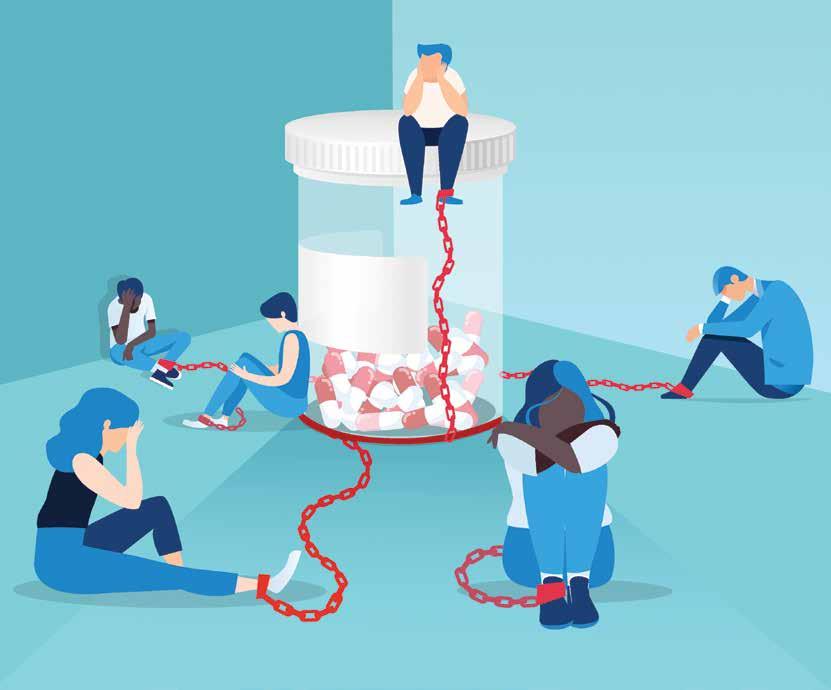
11 minute read
OPIOID ADDICTION: AN INDUSTRY PRIORITY
by ORBA/OAPC
Opioid addiction: An industry priority
Written by: Matt Bradford
It’s difficult to downplay the risks of opioid addiction in construction. At last count, sector workers accounted for the lion’s share of opioid-related deaths in Ontario alone, and the numbers are equally concerning across Canada. It’s a worker health and safety issue with immense implications, but one that can be combated with greater awareness, empathy, and proven prevention measures.
29,052 Canadians died of opioid toxicity deaths in 2021, approximately 21 deaths per day.
Addressing opioid addiction begins with acknowledging the threat. And indeed, a report from Public Health Ontario (PHO) frames the issue in no uncertain terms, indicating that one out of thirteen opioid deaths between 2018 and 2020 occurred among individuals in the construction industry, totaling 366 lives lost. Moreover, the PHO’s research states that over half of these victims were employed at their time of death and that 90 per cent of incidents were directly related to the use of nonpharmaceutical opioids (e.g. fentanyl). “It’s a public health crisis we can’t ignore,” says Mark Barnes, pharmacist and owner with Respect Rx Pharmacies and NaloxoneCare.com. “This isn’t a new crisis either; we’ve seen the problem of opioid addiction take shape for years. And right now we know that one-third of all individuals employed at the time of their overdose were employed in the construction industry.”
Understanding the physical and mental drivers
Opioid addiction is a public health issue prone to stereotypes and misconceptions. While statistics from the government of Canada point to middle-aged males as the demographic most likely to be affected, individuals of every age and background are susceptible.
If there is a common thread between opioid-related deaths and hospitalizations in Canada, it’s that a majority of the affected individuals began taking the drug in response to physical or mental trauma in their lives. In the construction sector specifically, PHO reports that 78 per cent of workers who lost their lives to an opioid overdose had an injury or pain diagnosis in the five years leading up to their incident (nearly a quarter within one week prior), while 82 per cent had seen a healthcare professional for a mental health issue over the same period.
“This is a very multifaceted issue involving a lot of moving parts,” says Lauren Poel, a mental health and addictions professional and author of this issue of RoadBuilder’s deep dive into addiction. “For one, we know that this industry is hard on the body, not to mention the aging body. Therefore, a lot of substance use results from past or present injuries. However, it is also important to look at the mental health issues that can arise in the industry as well.”
There are no shortage of mental health factors to consider. As anyone in the field can attest, construction workers can find themselves working long and ››
irregular hours in risky, remote, or uncomfortable environments. Some are also likely to feel “stuck” and bored in their positions, while others may live under the constant stress of not knowing when they might be laid off.
“Construction is an industry where a high number of people, for one reason or another, live paycheque to paycheque and feel that they can’t afford to take a day off,” says John Savoia, Director of Health and Safety, Powell Road Safety Group. “Trends show that even with injuries sustained at home or outside of working hours, or illnesses, workers still feel the need to come into work because they can’t afford not to, which is an issue in and of itself that employers may sometimes face.”

These attitudes and jobsite stressors can add up and contribute to a higher risk of developing a substance use disorder, especially among those who are already struggling with a mental health disorder or genetically predisposed to develop an addiction.
It also doesn’t help that the “work hard, play hard” mentality lingers in the construction industry. Even when employers make it clear that they’d rather injured workers take care of themselves before returning to work, employees may want to avoid looking “weak” or less dedicated than their peers. “And that kind of attitude becomes problematic when trying to deal with such a large issue like addiction and mental health,” adds Poel.
An invisible threat
Understanding where opioid-related deaths occur adds further insight for industry stakeholders. To that end, PHO research2 reveals that that a majority of deaths (79 per cent) occurred in a private residence, while less than 2 per cent actually occurred at the jobsite or a motel/hotel used for work purposes. More worrying still is that statistics indicate many of those who do die at home do not have an individual present to intervene.
“Opioid addiction isn’t something we see typically during working hours,” notes Savoia. “That’s not to say that people aren’t going home after work and engaging in activities which could have an effect on their performance and ability to work the next day such as using opioids, but there’s not a lot of instances where workers are coming to work showing clear cut signs of addiction at work, if any.”
James Stracey, Vice President of Emcon Services Inc.’s Ontario Division, agrees that opioid addiction issues are few and very far between in his corner of the industry, “I’ve seen very little within the highway maintenance industry.”
“People can mask their addictions very well,” Savoia adds. “It can be hard to recognize.” Visible or not, both
Stracey and Savoia agree that the issue remains one that needs to be on all companies’ radars, even if it might not manifest on the jobsite itself.
Support, not shame
The fact that many opioid-related deaths in construction are linked to physical or mental trauma is no small insight. It is a clear call that more needs to be done to create a culture where conversations are open and non-judgmental so that people are not afraid of losing their employment. “We have to stop judging why people use substances in the first place and address where that pain is coming from.”
Certainly, there is a need to address the attitudes and stereotypes that may prevent workers from talking openly about their physical and mental health issues. The key is dismantling the idea that “working through the pain” is the sign of a good worker, or that staying silent when hurt is the way of the business.
In addition to creating an environment where employees can speak openly about the issues that may lead them to opioids, there is a need to create greater training and awareness around spotting addictions when they take shape.
88% of all accidental apparent opioid toxicity deaths occurred in British Columbia, Alberta, or Ontario.
“Continual training is the key, especially when it comes to encouraging employees to be open about any potential issues that they may have encountered,” says Stracey. “Remember, too, construction is still a very male-oriented industry, and there are men who aren’t very good about talking about their problems. So we have to recognize that, too.”
Poel also advocates for more industry education on the topics of mental health and addiction, particularly in regards to helping employers recognize opioid addiction and respond if an overdose occurs on the job. “Knowledge is power,” she says. “And as we all know, the industry is in desperate need of workers, meaning companies need the employees they do have to stay healthy and thriving.”
Enter Bill 88
Responding to opioid addiction in construction is a responsibility shared by all stakeholders. Even still, incoming changes to Bill 88, Working for Workers Act, 20223, aim to shift a bulk of the liability to employers.
Specifically, the Occupational Health and Safety Act is amended by adding section 25.2 which states:
(1) Where an employer becomes aware, or ought reasonably to be aware, that there may be a risk of a worker having an opioid overdose at a workplace where that worker performs work for the employer, or where the prescribed circumstances exist, the employer shall,
(a) provide and maintain in good condition a naloxone kit in that workplace; and
(b) comply with any other prescribed requirements respecting the provision and maintenance of naloxone kits and the training referred to in subsection (3).

The amendment goes on to say that the training mentioned above should cover “how to recognize an opioid overdose, how to administer naloxone, and hazards related to administering naloxone.”
While the amendments bring greater attention to the issue of opioid addiction in the industry, there are concerns that Bill 88 may place a disproportionate amount of responsibility on employers’ shoulders. “The contractors or employees have been put on the front line of a critical public health issue, even though many of us aren’t really trained on how to deal with it,” says Stracey. “It feels like the ball has been passed to contractors.”
Bill 88 may be drafted with good intent, but some argue that more clarification and direction are needed if employers are expected to bear the brunt of its execution, or face heavy fines in the event they cannot.
Specifically, says Savoia, “People can hide an addiction with the best of them, so the part of the act that says employers ‘ought reasonably to be aware’ isn’t a great descriptor. I know I can’t always look at someone and say, ‘Oh, this person is clearly grappling with a drug problem,’ because there could be other things going on, and I don’t want to make assumptions.”
There are also concerns that Bill 88 does not offer clear direction or standards regarding the type of training needed to conform to the amendments. Additionally, the introduction of exponentially higher fines for employers who do not meet these standards has employers calling for more guidance and support ahead of the new rules.

These and other issues regarding Bill 88 were recently addressed in a joint statement provided to Monte McNaughton, Minister of Labour, Training and Skills Development, by ORBA and several industry partners in March 2022.
“As Ontario’s economy is still on the road to recovery, new regulations which directly impact business operations should be done so prudently and meticulously. Bill 88 provides the government a unique opportunity to strengthen workplace health and safety while avoiding placing unreasonable risk on the business community,” it reads.
Yet, despite the gaps, there is a general consensus that Bill 88 is a step in the right direction. Moreover, Barnes is confident that the clarity the industry seeks will come down from Queen’s Park as the Bill gets closer to becoming a reality. Overall, he says, “It’s a fantastic initiative. To have a non-health minister lead a Bill that says he wants to make sure our employers come to work safe and stay safe is a great thing to see.”
Fit for duty
Bill 88 or not, there’s no arguing that employers have a degree of responsibility when it comes to addressing the opioid issue. Promisingly, many in road building and across the industry are already taking the obligation to heart, embedding opioid addiction training within their health and safety programs and making naloxone kits available within their sites.
“It all comes down to having a system in place where ‘fit for duty’ is at the top of every supervisor’s mind each and every day or night, and they are trained to recognize the signs that would indicate one of their workers is unfit for duty,” says Savoia. “Honestly, that’s the best thing that a company could do — have policies, procedures, and protocols in place to make sure the people on site are fit to be there. And if they’re not, that we ensure work is stopped, an investigation is undertaken, and the individual gets home safe and gets the support they need.”
Opioid addiction has taken root in construction. Tackling the issue requires a united effort among all stakeholders to address the root causes, respond effectively to overdoses, and provide workers with the training and support they need to avoid becoming another statistic.








